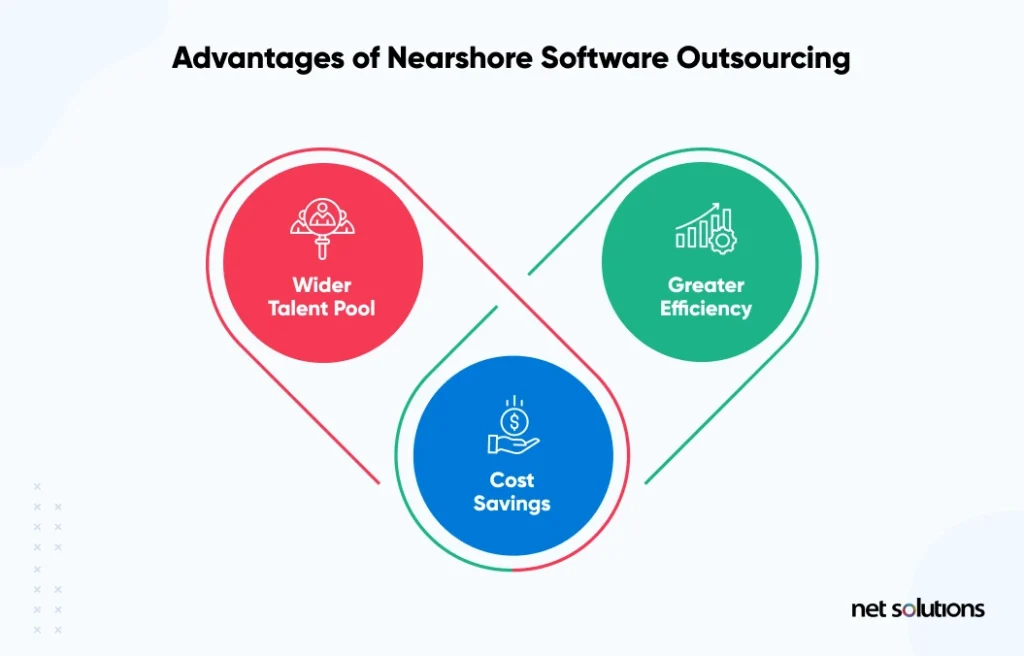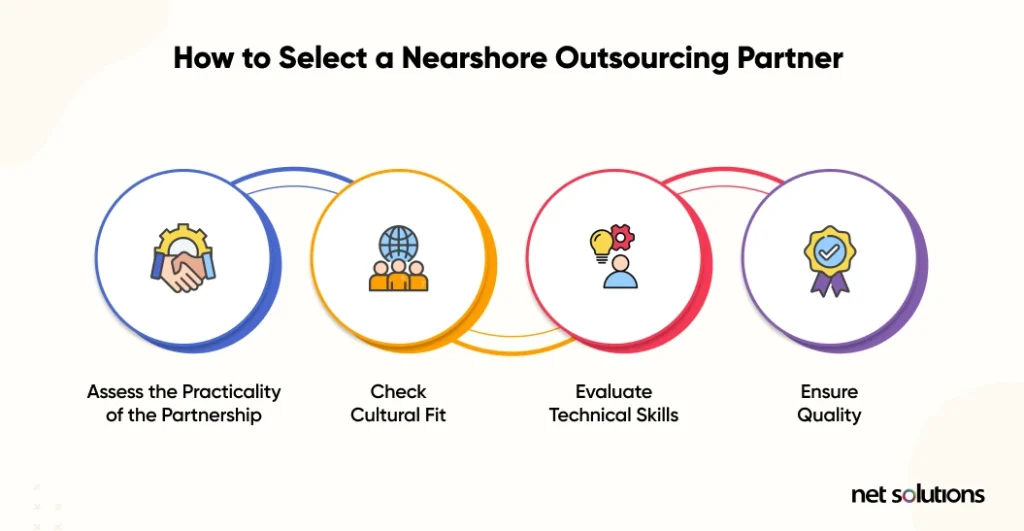When most people think about outsourcing services, they imagine working with an outsourced team on another continent or even the opposite side of the world.
While hiring an offshore software development team comes with plenty of benefits, it’s not the only option for companies looking to outsource. Some companies work, instead, with nearshore teams—outsourcing companies located in relatively nearby countries in similar time zones.
If you’re considering hiring a nearshore development partner, you’ll want to evaluate the benefits and drawbacks of working with a nearshore company. This guide will help you do just that.
What Is Nearshore Software Development Outsourcing?
Nearshore software development outsourcing is hiring a software development partner in a nearby country and a similar time zone. For example, when a German company hires a development team in Eastern Europe, or a U.S. company hires a Mexican or Canadian development firm, they are engaging in nearshoring.
Like all outsourcing, nearshoring comes with a number of benefits, assuming you work with a reputable firm that hires talented software engineers. From reducing costs to improving efficiency and time-to-market, both nearshoring and offshoring can give you a competitive advantage.
Of course, nearshoring and offshoring each have their own potential advantages, and we’ve written this guide post to discuss both the pros and cons of using nearshore software development services.
Check one of our previous guide to discover the latest outsourcing statistics and data, along with a broad overview of the outsourcing industry.
Why Companies Consider Nearshore Software Development Outsourcing
What inspires companies to go the nearshore software development route, as opposed to engaging in IT outsourcing with someone in a distant country? Here are three reasons why companies might choose to work with a nearby partner.
Minimal time zone differences
While working with someone on the opposite side of the globe has the advantage of round-the-clock production, it can also present some challenges for those companies that don’t want to work asynchronously. Of course, some offshore partners are willing to adapt to your hours, which we do here at Net Solutions, so it’s not necessarily a deal breaker.
When working with a nearshore company, time zone challenges are no longer an issue. The proximity of a nearshore partner results in no more than a few hours of disconnect—something companies in large countries like the U.S. deal with every day when they’ve got offices a few states over.
If matching time zones is important to you, it makes sense to either (A) Hire a nearshore partner or (B) Work only with companies willing to adapt to your work hours (regardless of where they’re located).
Nearby location
Companies today can conduct business without ever meeting face-to-face, but some still prefer live meetings. Nearshoring offers the distinct advantage of meeting face-to-face if that’s something you prefer.
A Los Angeles team working with a nearshore development firm in Mexico City or Vancouver can hop a non-stop flight, meet with their outsourcing partners, and fly back the next day. By contrast, traveling from L.A. to the Philippines a couple of times each quarter would be completely impractical.
Fewer language and cultural differences (sometimes!)
Nearshoring can sometimes be a way to reduce linguistic and cultural differences, resulting in easier communication—but note the qualifier! We say sometimes because you may experience more cultural similarities when working with someone on the opposite side of the world. It really depends on the outsourcing country you choose.
For example, a company located in Geneva (the French-speaking part of Switzerland) that chooses to work with software engineers in Lyon, France, will have virtually no cultural or linguistic barriers to face.
However, a Spanish company would likely have an easier time communicating with a firm in Colombia (or another Spanish-speaking country in Latin America) than they would with another nearby European firm, where English would serve as their only common language.
Similarly, U.S. companies often find it easier to work with outsourcing firms in India, even though India is about as far as you can get from the U.S.
Why? India’s educated population is exceptionally fluent in English. When U.S. companies vet potential partners for their communication skills, they often find that their Indian partners are just as fluent in English as many members of their in-house teams.
How Does Nearshore Software Development Outsourcing Work?
Nearshore outsourcing works very much like offshore and onshore outsourcing. Companies of all sizes, from startups to enterprises, hire outside firms to support their IT needs. This might involve:
- Custom software development (including project management, design, QA, and more)
- Staff augmentation to extend the capabilities of in-house teams
- Digital transformation and cloud-computing guidance
- IT support
- Consulting
- Other IT and technology-related needs
When you hire an outsourcing partner, the firm’s employees work for them, even if they interface with your team every day. That means you don’t have to worry about hiring, firing, paying payroll taxes, and other hassles and expenses associated with managing in-house staff.
How Does Nearshore Differ From Other Outsourcing Models?
Nearshore, onshore, and offshore outsourcing are all similar. Each may involve hiring a dedicated team or individual talent, and all three help companies produce software products more efficiently and at a lower cost. That said, each approach has some unique qualities that may influence your final decision.
Nearshore vs. Offshore
The main thing that separates nearshore outsourcing from offshore outsourcing is geographic proximity. Outsourcing to a nearby country with only a 1-2 hour time difference is considered nearshoring, while outsourcing to a country farther away is considered offshoring.
Of course, that begs the question: How far is “far away?” When does nearshoring change to offshoring? San Diego, California (USA), is 3,600 miles (nearly 6,000 KM) from Nova Scotia, Canada, with a four-hour time difference. Is that still nearshoring? After all, it’s just one country over with a very similar culture.
The truth is that these terms aren’t binary, and in many cases, the difference between offshoring and onshoring is a judgment call. In fact, the similarities often outweigh the differences, since in both cases you’re dealing with international outsourcing.
Nearshore vs. Onshore
There’s a greater difference between nearshoring and onshoring than between nearshoring and offshoring, simply because onshoring involves dealing with outsourcing firms within your own country.
Onshoring has the advantage of dealing with similar labor laws, though not necessarily identical laws, since labor laws can vary between states, provinces, and sometimes cities. Onshoring almost always eliminates major cultural and language barriers, but it’s not nearly as cost-effective as going overseas to find tech talent.
What Are The Advantages of Nearshore Software Outsourcing?

In truth, nearshoring offers many of the same benefits that offshoring offers. We’ll outline three of those benefits here.
Wider talent pool
Finding qualified developers is of vital importance these days, with 50% of U.S. companies listing talent acquisition as a top priority according to a recent report by Deloitte. Given the current developer shortage, enterprises are turning to outsourcing companies beyond their home countries to help support their IT services and software development goals.
Nearshoring allows companies to expand beyond their borders, broadening their selection of tech talent to choose from.
Cost savings
Outsourcing, in general, offers tremendous cost savings, since companies forgo the hidden costs of hiring in-house (e.g., recruiting and onboarding costs, paying benefits, payroll taxes).
Working with software companies in nearby countries with lower costs of living, such as Western European countries working with firms in Romania or Ukraine, can reduce costs and boost profits.
Greater efficiency
Working with nearshore partners who are experienced in application development and well-versed in methodologies like Agile and DevOps can expedite your development process.
Finding the right outsourcing partner, whether nearshore, onshore, or offshore, can speed up your time-to-market, offering a powerful competitive advantage.
How to Choose a Nearshore Software Outsourcing Partner
Your selection strategy will greatly impact your odds of success, which is why we recommend thoroughly vetting any outsourcing partners you hire. If you take a nearshoring approach to your outsourcing endeavor, the following tips will help you select a qualified partner.
Assess the practicality of outsourcing partnerships

An outsourcing relationship should be smooth and efficient, and your partner’s processes must gel with yours to form a synergistic relationship. A number of factors must fall into place to make that happen, including the following.
- Language fluency: Does your outsourcing partner clearly speak and understand English (or your operating language) on a nuanced level? Can they discuss and explore strategic objectives with you? If they struggle, you will waste valuable time trying to explain your ideas in a way they understand.
- Communication and collaboration: Going beyond fluency, does your potential partner have systems in place to communicate clearly, such as regular meeting times and defined communication channels?
- Established systems and processes: Does your potential partner use Agile and DevOps methodologies, or other systems, to think strategically about software development? Without systems to tame the chaos, outsourcing may not actually make you more efficient or increase profits.
Cultural fit
No matter where your outsourcing partner is located, cultural fit is vital—both in terms of understanding your socio-linguistic culture as well as your company culture.
When you meet with their staff, do you get the sense that they share your values, work ethic, mindset, and sense of humor? Can you relate to them the way you might relate to your full-time colleagues?
That might sound like a tall order when working with a company in a radically different culture and country, but we assure you it’s not! Our planet is more interconnected now than ever.
Here at Net Solutions, we’ve forged deep connections and even friendships with our clients and vendors on opposite sides of the world. With that in mind, if you don’t feel a strong cultural fit when interviewing potential nearshore partners, keep searching.
Evaluate technical skills
Needless to say, strong technical skills in the areas you require are an absolute must when hiring a nearshore partner. So, how do you evaluate those skills?
- Review case studies: Look for thorough case studies on the potential partner’s website and note which programming languages and tech stacks they used. Do those match your needs?
- Ask challenging questions: Discuss your project and ask your prospective partner’s technical team to describe how they would approach it. Ask tough questions about their tech strategy to evaluate their expertise.
- Ask for references: Client testimonials and case studies are important, but they are no substitute for hearing from actual clients. Ask how your potential partner performed on their project and whether there was anything they wish they’d done differently.
Quality Assurance (QA)
What is your prospective partner’s approach to QA and testing? Make sure any nearshore partner you hire follows best practices and uses the latest tools to minimize bugs and optimize security and compliance.
When vetting a potential nearshore partner, ask them to describe their approach to Quality Assurance, including their:
- Testing automation tools
- Processes for communicating bugs to development teams
- Approach to security testing (e.g., do they use a DevSecOps approach?)
- Approach to compliance requirements related to your industry
Quality Assurance is not something to overlook in your quest for a nearshore partner. It’s just as important as design and development skills, and it should weigh heavily in your vetting criteria.
Can Offshore Outsourcing Beat Nearshoring?
Given everything we’ve mentioned here, you may be wondering which is better, offshoring or nearshoring?
Both come with distinct advantages over onshoring, such as cost savings and accessing a wider talent pool. That said, how do you decide between working with a team in a nearby country vs. one on the opposite side of the world?
Nearshore firms offer an advantage for those who want to meet with their outsourcing partners face-to-face, while offshoring partners often provide a wider range of talent and choices since the whole world is an option.
In many cases, offshore providers can offer more competitive rates, but you’ll want to review our comprehensive guide to software development rates around the world to determine if that’s the situation for you.
Last but not least is the question of work hours and time zone differences. Nearshore partners present minimal time zone challenges, but of course, offshore partners who can adapt to your work hours (like we do here at Net Solutions) won’t present a problem either.
In some cases, in fact, you may want all or part of your outsourcing team to work asynchronously. That’s what Kitco asked us to do when we performed QA testing for their Android app. Their developers worked during the day, and while they were home in bed, our teams ran tests and delivered full bug reports that were ready for them when they came to work.
Hire an Experienced Outsourcing Partner
Are you looking for an outsourcing partner who understands your culture, speaks fluent English, and can adapt to your work hours?
Net Solutions has been in business for over 20 years. As a full-service software development firm, we’ve designed, created, and managed software development projects for the Harvard Business Review, American Golf, IMG, and countless startups.
Curious to see what we can do for you?
SHARE THIS POST
Table of Contents
Related Resources
- 10 Key Benefits of Outsourcing Software Development
- 10 Common Software Outsourcing Challenges [With Solutions]
- 19 Best Software Development Outsourcing Companies in 2024
- How Much Does It Cost to Outsource Software Development?
- Software Development Outsourcing: India's Top 11 Contenders
- Comparing Software Development Outsourcing Models: A Decision-Maker's Guide
- Outsourcing Software Development: Evaluating the Pros and Cons
- 15 Questions to Ask when Outsourcing Software Development
- Outsourcing Software Development for Startups [2024 Guide]
- 2024 Software Development Outsourcing Statistics: Trends, Insights & Predictions
- Software Development Outsourcing Trends

